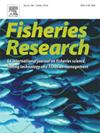Elasmobranch research in the Mediterranean Sea: What is known, what is not, how it changed, and where it needs to go
IF 2.2
2区 农林科学
Q2 FISHERIES
引用次数: 0
Abstract
The analysis of 1212 research contributions across 22 coastal states offers insights into how Mediterranean countries contributed to knowledge on elasmobranchs in the period between 1932 and 2020. During this time, research on elasmobranch species has steadily increased, yet research efforts across countries varied, with European Union (EU) Member States generally being involved in more publications than other countries in the region. The consideration of elasmobranchs in international law and regional frameworks seems to have driven this growth, and more researchers started to focus on these species. A total of 301 Mediterranean entities, mostly universities (44.5 %), contributed to research on elasmobranchs regionally, with 95 of them having published regularly. A trend in the application of non-lethal methods was noted, although fisheries-dependent data remains an important source of information. Research on the biology, ecology, taxonomy, pollution (contamination), and the fishing of elasmobranchs have been consistent subjects in this field, while other topics such as ‘conservation and management measures’ and ‘shark meat trade and consumption’ have increased in recent years. However, gaps in knowledge on policy implementation and important areas remain.
地中海的Elasmobranch研究:什么是已知的,什么是未知的,它是如何变化的,它需要去哪里
通过对22个沿海国家的1212项研究成果的分析,我们可以深入了解地中海国家在1932年至2020年期间是如何对板鳃亚目的知识做出贡献的。在此期间,对板鳃科物种的研究稳步增加,但各国的研究力度各不相同,欧盟成员国通常比该地区其他国家参与更多的出版物。国际法和区域框架对板鳃亚目的考虑似乎推动了这种增长,越来越多的研究人员开始关注这些物种。共有301个地中海实体,大多数是大学(44.5% %),对区域内的elasmobrantes研究作出了贡献,其中95个实体定期发表了论文。尽管依赖渔业的数据仍然是一个重要的资料来源,但仍注意到采用非致命方法的趋势。生物、生态学、分类学、污染(污染)和捕鲨一直是该领域的研究主题,而“保护和管理措施”和“鲨鱼肉贸易和消费”等其他主题近年来也有所增加。然而,在政策执行和重要领域的知识方面仍然存在差距。
本文章由计算机程序翻译,如有差异,请以英文原文为准。
求助全文
约1分钟内获得全文
求助全文
来源期刊

Fisheries Research
农林科学-渔业
CiteScore
4.50
自引率
16.70%
发文量
294
审稿时长
15 weeks
期刊介绍:
This journal provides an international forum for the publication of papers in the areas of fisheries science, fishing technology, fisheries management and relevant socio-economics. The scope covers fisheries in salt, brackish and freshwater systems, and all aspects of associated ecology, environmental aspects of fisheries, and economics. Both theoretical and practical papers are acceptable, including laboratory and field experimental studies relevant to fisheries. Papers on the conservation of exploitable living resources are welcome. Review and Viewpoint articles are also published. As the specified areas inevitably impinge on and interrelate with each other, the approach of the journal is multidisciplinary, and authors are encouraged to emphasise the relevance of their own work to that of other disciplines. The journal is intended for fisheries scientists, biological oceanographers, gear technologists, economists, managers, administrators, policy makers and legislators.
 求助内容:
求助内容: 应助结果提醒方式:
应助结果提醒方式:


